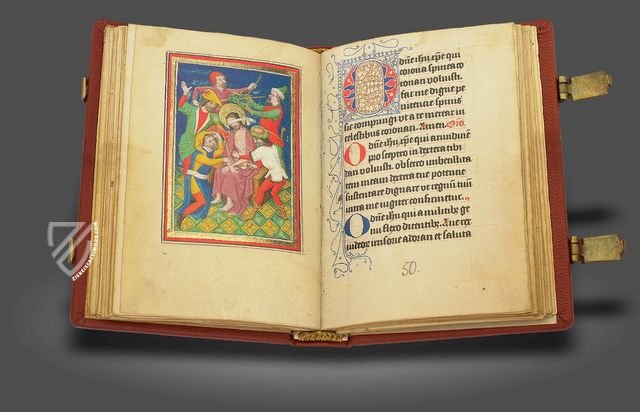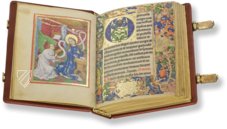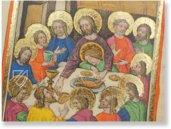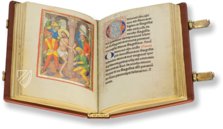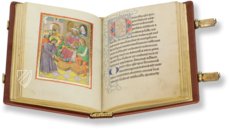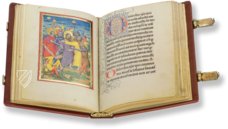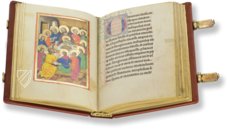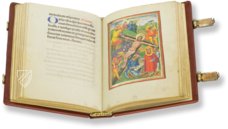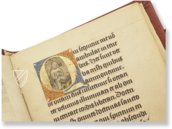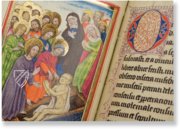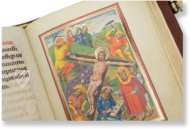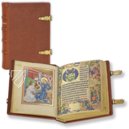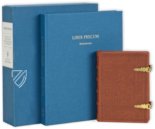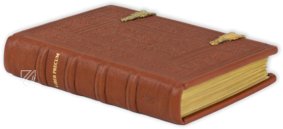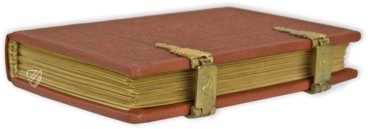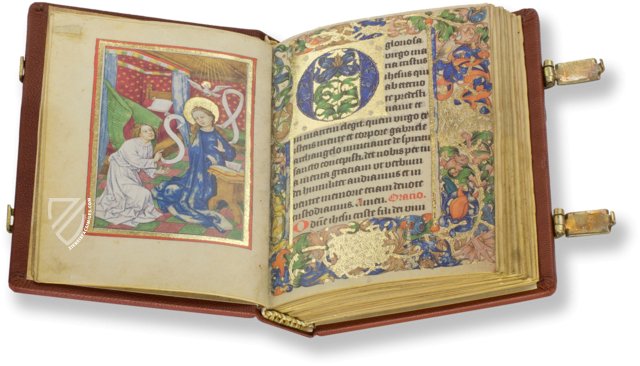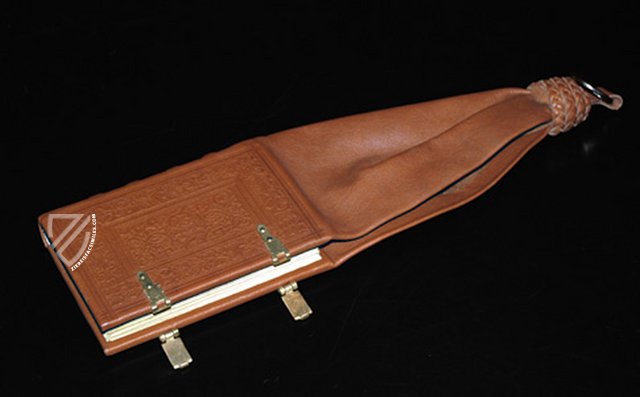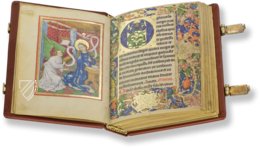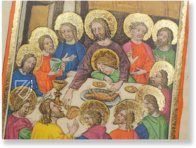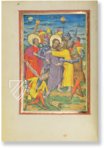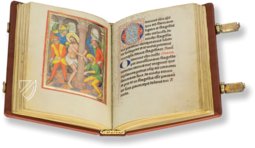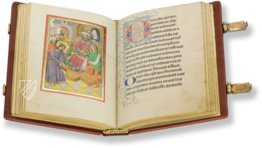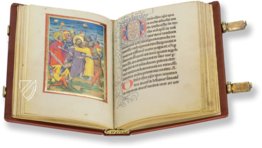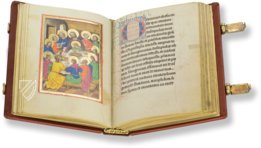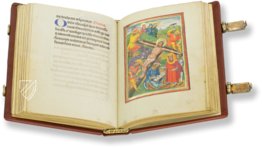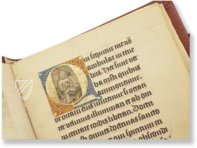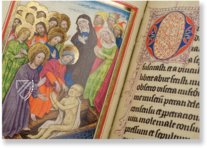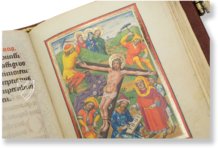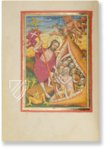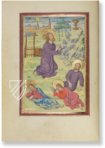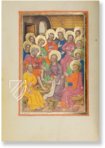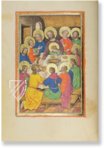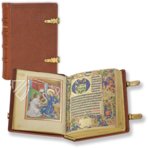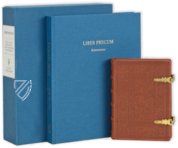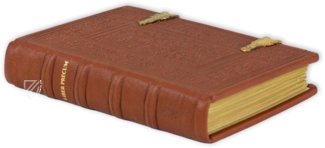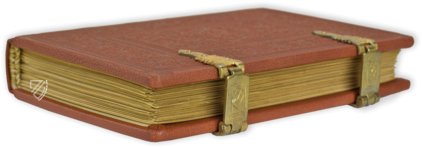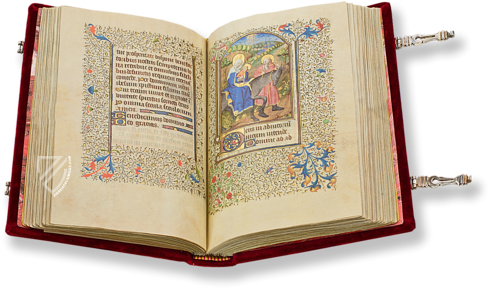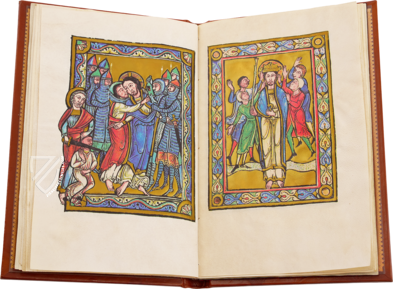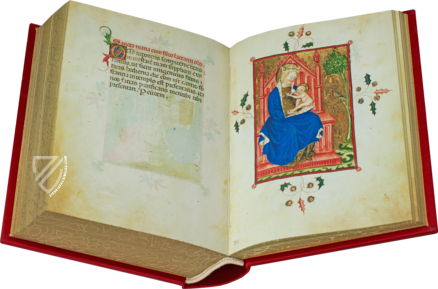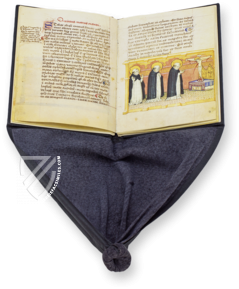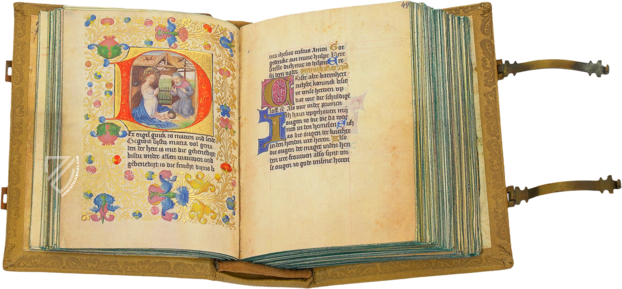Liber Precum
(1,000€ - 3,000€)
A previously unknown masterpiece of the Late Middle Ages was made in Cologne between 1480 and 1490: the Liber Precum, which now resides in the Russian National Library in St. Petersburg. Aside from the illumination, which is the work of one of the leading masters of the Cologne painting school, the manuscript boast a thus-far unparalleled choice of texts. Featuring 41 full-page miniatures, the prayer section of the small-format book is arranged with the miniatures always opposite of their corresponding prayers on the life of Christi. Thus, devotion and meditation were to be performed through images and words in order to deeply comprehend the suffering of Christ - very much in the spirit of late medieval lay piety. The illustrations also combine the "Soft Style" of illumination with a newer, more realistic approach, making them of particular interest, like other transitionary works. This precious gem came to Russia via the later Grand Duchess and Tsarina Sophie Dorothée of Württemberg (1759–1828), who brought it with her to the Imperial Russian Court.
Liber Precum
The facsimile of the Liber Precum now in St. Petersburg places a hitherto unknown masterpiece of late medieval illumination at the center of interest of both bibliophiles and scholars alike. Made between 1480 and 1490 in Cologne, one of the foremost schools of illumination at the time, the small-sized volume presents a number of particular features which make it stand out among the countless prayer books produced in this period, conferring on it an unmistakable character and significance. One of its extraordinary features is a thus-far unparalleled choice of texts. The biggest surprise, however, is the illustrated cycle on the life and passion of Christ, which in terms of form, function, subject matter, and because of its large content, presents a true highlight of 15th century book illumination.
A Unique Illustrated Cycle on the Life of Christ
The most striking feature of the Liber Precum now in St. Petersburg, is no doubt its cycle of illustrations, which is truly unmatched because of its extent and its narrative and artistic qualities. It constitutes the most complete and, iconographically speaking, richest picture cycle on the life and Passion of Christ ever made in this era of illumination. A total of 41 full-page miniatures illustrate the prayers in the first portion of the manuscript, which is now the object of a faithfully reproduced facsimile edition. Special attention is to be paid to the fact that the illustrations on the left hand page are paired with the relevant texts on the page opposite. When following the natural line of sight, they provide the visual impulse necessary to grasp the theme and mood conveyed in the subsequent prayer texts. The textual significance of the manuscript as a devotional book is mirrored by the overall tone underlying the miniatures, intended to convey all kinds of emotions. The dynamic figures interlinked by eloquent gestures, facial expressions, and a certain inner tension, the atmospheric scenery and the subtle color tones are all dominating elements that give the illustrations their particular charm, obviously the work of a highly talented master of his genre.
The Soft Style
During the second half of the 15th century, the artist was one of the leading protagonists of the painting school in Cologne from which emanated decisive impulses for the development of panel painting in Germany throughout the 15th century. One of its prominent masters, Stephan Lochner, is thought to have perfected the so-called "Weicher Stil" (Soft Style) in late Gothic painting. The foremost achievement of the painting style developed in Cologne - a mixture of the delicate Soft Style and a new realistic approach - not only dominated the large art form of panel painting but also entered the sphere of book illumination where it was mainly used in full-page miniatures. The models used for our manuscript to which its creator owes his name, show it as being the work of an outstanding artist who mastered the new style down to the tiniest details. In this prayer book, the "Master of the Liber Precum in St. Petersburg" created a jewel to further enrich the large and varied corpus of German late medieval illuminated books.
A Monument to Modern Piety
Another striking feature is the choice of text, which deviates largely from the usual scheme: the manuscript contains two larger portions of text that were written and decorated separately. The first one comprising a sequence of prayers on the Vita Christi (life and passion of Christ), while the second one assembles a series of prose and verse sermons as well as a further series of prayers. This choice of texts reflects the ambition to deepen the personal devotion of the readers and to make them follow the example and teachings of Christ in their everyday life. The work is thus in line with the tradition of "devotio rnoderria", an important spiritual movement founded in the 14th century and whose everyday mysticism led to it being ever more widely acclaimed in a time of political upheaval, which also had an impact on ecclesiastical matters.
Journey to the Russian Imperial Court
It seems a stroke of fate that our manuscript was kept in the summer residence of Empress Maria Fyodorovna in Pavlovsk until the year 1929. Sophie Dorothée von Württemberg had married the Russian Grand Duke and later Tsar Paul I in 1776 and enjoyed wide popularity throughout the country due to her work for charity and as a patroness of the arts. Her heirs finally bequeathed the prayer book to the Russian National Library in nearby St. Petersburg, located only 30 km from Pavlovsk Palace.
Codicology
- Alternative Titles
- Book of Sermons
- Size / Format
- 560 pages / 13.0 × 9.5 cm
- Origin
- Germany
- Date
- Between 1480 and 1490
- Epochs
- Style
- Genre
- Language
- Script
- Gothic Textura
- Illustrations
- 41 full-page miniatures framed and decorated with gold; 1 historiated initial
- Content
- Vita Christi with the miniatures always opposite of their corresponding prayers
- Artist / School
- Master of the Liber Precum in St. Petersburg
- Previous Owners
- Tsarina Maria Feodorovna a.k.a. Sophie Dorothée of Wuerttemberg (1759–1828)
Liber Precum
Jesus Washing the Disciples’ Feet
One of the most powerful images from the story of the Vita Christi is that of Jesus, son of God, bathing the feet of his disciples in an unbelievable act of humility that they initially try to resist. “For I have given you an example, that you should do as I have done to you. Most assuredly, I say to you, a servant is not greater than his master; nor is he who is sent greater than he who sent him. If you know these things, blessed are you if you do them.” (Jn 13:15-17)
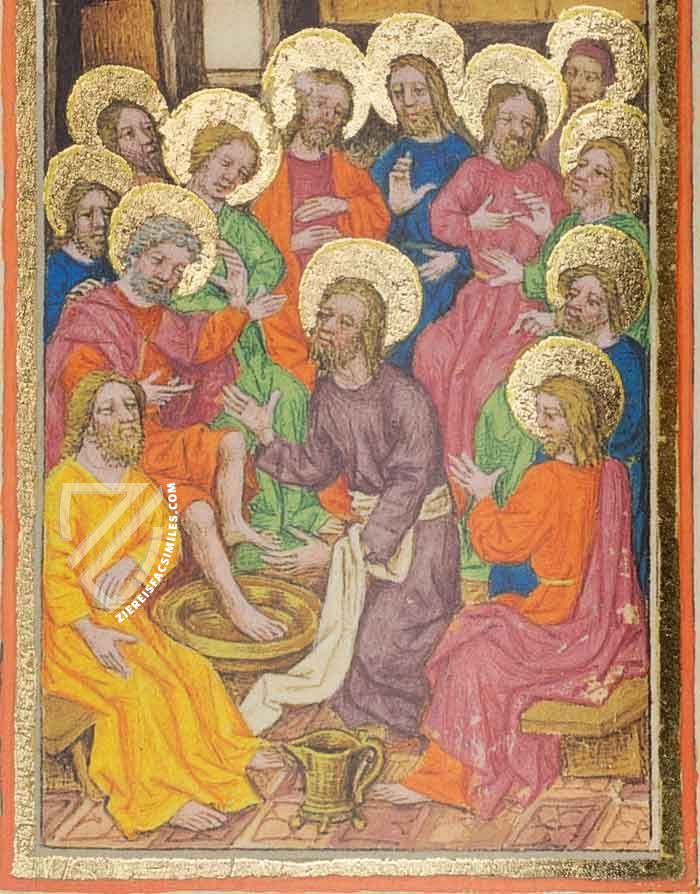
Liber Precum
Kiss of Judas
This famous scene from the Garden of Gethsemane is one of the most popular in medieval Christian art. This scene mixes classical forms, such as the robes worn by Jesus and his disciples, with contemporary clothing and armor worn by the soldiers who have come to arrest Jesus. In the scene, Jesus is seized in the moment that he is kissed by the treacherous Judas.
This colorful scene it presented within an understated frame of red and gold leaf. Although Christ is at the center of the scene and highlighted with a gold leaf halo, the bright yellow robe worn by Judas draws attention to his treachery. The armor of the period is portrayed with a surprising degree of detail, as are the boots, tights, and hats that were popular at the time.
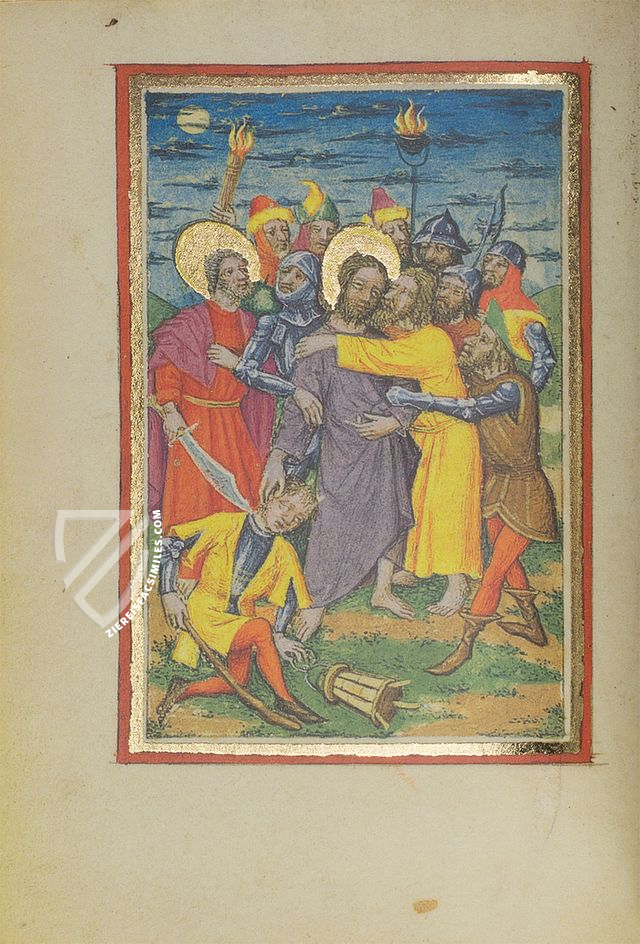
#1 Der Liber Precum (Normal Edition)
Languages: English, German
(1,000€ - 3,000€)
#2 Der Liber Precum (Special Girdle Book Edition)
Languages: English, German
(3,000€ - 7,000€)
- Treatises / Secular Books
- Apocalypses / Beatus
- Astronomy / Astrology
- Bestiaries
- Bibles / Gospels
- Chronicles / History / Law
- Geography / Maps
- Saints' Lives
- Islam / Oriental
- Judaism / Hebrew
- Single Leaf Collections
- Leonardo da Vinci
- Literature / Poetry
- Liturgical Manuscripts
- Medicine / Botany / Alchemy
- Music
- Mythology / Prophecies
- Psalters
- Other Religious Books
- Games / Hunting
- Private Devotion Books
- Other Genres
- Afghanistan
- Armenia
- Austria
- Belgium
- Belize
- Bosnia and Herzegovina
- China
- Colombia
- Costa Rica
- Croatia
- Cyprus
- Czech Republic
- Denmark
- Egypt
- El Salvador
- Ethiopia
- France
- Germany
- Greece
- Guatemala
- Honduras
- Hungary
- India
- Iran
- Iraq
- Israel
- Italy
- Japan
- Jordan
- Kazakhstan
- Kyrgyzstan
- Lebanon
- Liechtenstein
- Luxembourg
- Mexico
- Morocco
- Netherlands
- Palestine
- Panama
- Peru
- Poland
- Portugal
- Romania
- Russia
- Serbia
- Spain
- Sri Lanka
- Sweden
- Switzerland
- Syria
- Tajikistan
- Turkey
- Turkmenistan
- Ukraine
- United Kingdom
- United States
- Uzbekistan
- Vatican City
- A. Oosthoek, van Holkema & Warendorf
- Aboca Museum
- Ajuntament de Valencia
- Akademie Verlag
- Akademische Druck- u. Verlagsanstalt (ADEVA)
- Aldo Ausilio Editore - Bottega d’Erasmo
- Alecto Historical Editions
- Alkuin Verlag
- Almqvist & Wiksell
- Amilcare Pizzi
- Andreas & Andreas Verlagsbuchhandlung
- Archa 90
- Archiv Verlag
- Archivi Edizioni
- Arnold Verlag
- ARS
- Ars Magna
- ArtCodex
- AyN Ediciones
- Azimuth Editions
- Badenia Verlag
- Bärenreiter-Verlag
- Belser Verlag
- Belser Verlag / WK Wertkontor
- Benziger Verlag
- Bernardinum Wydawnictwo
- BiblioGemma
- Biblioteca Apostolica Vaticana (Vaticanstadt, Vaticanstadt)
- Bibliotheca Palatina Faksimile Verlag
- Bibliotheca Rara
- Boydell & Brewer
- Bramante Edizioni
- Bredius Genootschap
- Brepols Publishers
- British Library
- C. Weckesser
- Caixa Catalunya
- Canesi
- CAPSA, Ars Scriptoria
- Caratzas Brothers, Publishers
- Carus Verlag
- Casamassima Libri
- Centrum Cartographie Verlag GmbH
- Chavane Verlag
- Christian Brandstätter Verlag
- Circulo Cientifico
- Club Bibliófilo Versol
- Club du Livre
- CM Editores
- Collegium Graphicum
- Collezione Apocrifa Da Vinci
- Comissão Nacional para as Comemorações dos Descobrimentos Portugueses
- Coron Verlag
- Corvina
- CTHS
- D. S. Brewer
- Damon
- De Agostini/UTET
- De Nederlandsche Boekhandel
- De Schutter
- Deuschle & Stemmle
- Deutscher Verlag für Kunstwissenschaft
- DIAMM
- Droz
- E. Schreiber Graphische Kunstanstalten
- Ediciones Boreal
- Ediciones Grial
- Ediclube
- Edições Inapa
- Edilan
- Editalia
- Edition Deuschle
- Edition Georg Popp
- Edition Leipzig
- Edition Libri Illustri
- Editiones Reales Sitios S. L.
- Éditions de l'Oiseau Lyre
- Editions Medicina Rara
- Editorial Casariego
- Editorial Mintzoa
- Editrice Antenore
- Editrice Velar
- Edizioni Edison
- Egeria, S.L.
- Eikon Editores
- Electa
- Emery Walker Limited
- Enciclopèdia Catalana
- Eos-Verlag
- Ephesus Publishing
- Ernst Battenberg
- Eugrammia Press
- Extraordinary Editions
- Fackelverlag
- Facsimila Art & Edition
- Facsimile Editions Ltd.
- Facsimilia Art & Edition Ebert KG
- Faksimile Verlag
- Feuermann Verlag
- Folger Shakespeare Library
- Franco Cosimo Panini Editore
- Friedrich Wittig Verlag
- Fundación Hullera Vasco-Leonesa
- G. Braziller
- Gabriele Mazzotta Editore
- Gebr. Mann Verlag
- Gesellschaft für graphische Industrie
- Getty Research Institute
- Giovanni Domenico de Rossi
- Giunti Editore
- Graffiti
- Grafica European Center of Fine Arts
- Guido Pressler
- Guillermo Blazquez
- Gustav Kiepenheuer
- H. N. Abrams
- Harrassowitz
- Harvard University Press
- Helikon
- Hendrickson Publishers
- Henning Oppermann
- Herder Verlag
- Hes & De Graaf Publishers
- Hoepli
- Holbein-Verlag
- Houghton Library
- Hugo Schmidt Verlag
- Idion Verlag
- Il Bulino, edizioni d'arte
- ILte
- Imago
- Insel Verlag
- Insel-Verlag Anton Kippenberger
- Instituto de Estudios Altoaragoneses
- Instituto Nacional de Antropología e Historia
- Introligatornia Budnik Jerzy
- Istituto dell'Enciclopedia Italiana - Treccani
- Istituto Ellenico di Studi Bizantini e Postbizantini
- Istituto Geografico De Agostini
- Istituto Poligrafico e Zecca dello Stato
- Italarte Art Establishments
- Jan Thorbecke Verlag
- Johnson Reprint Corporation
- Josef Stocker
- Josef Stocker-Schmid
- Jugoslavija
- Karl W. Hiersemann
- Kasper Straube
- Kaydeda Ediciones
- Kindler Verlag / Coron Verlag
- Kodansha International Ltd.
- Konrad Kölbl Verlag
- Kurt Wolff Verlag
- La Liberia dello Stato
- La Linea Editrice
- La Meta Editore
- Lambert Schneider
- Landeskreditbank Baden-Württemberg
- Leo S. Olschki
- Les Incunables
- Liber Artis
- Library of Congress
- Libreria Musicale Italiana
- Lichtdruck
- Lito Immagine Editore
- Lumen Artis
- Lund Humphries
- M. Moleiro Editor
- Maison des Sciences de l'homme et de la société de Poitiers
- Manuscriptum
- Martinus Nijhoff
- Maruzen-Yushodo Co. Ltd.
- MASA
- Massada Publishers
- McGraw-Hill
- Metropolitan Museum of Art
- Militos
- Millennium Liber
- Müller & Schindler
- Nahar - Stavit
- Nahar and Steimatzky
- National Library of Wales
- Neri Pozza
- Nova Charta
- Oceanum Verlag
- Odeon
- Orbis Mediaevalis
- Orbis Pictus
- Österreichische Staatsdruckerei
- Oxford University Press
- Pageant Books
- Parzellers Buchverlag
- Patrimonio Ediciones
- Pattloch Verlag
- PIAF
- Pieper Verlag
- Plon-Nourrit et cie
- Poligrafiche Bolis
- Presses Universitaires de Strasbourg
- Prestel Verlag
- Princeton University Press
- Prisma Verlag
- Priuli & Verlucca, editori
- Pro Sport Verlag
- Propyläen Verlag
- Pytheas Books
- Quaternio Verlag Luzern
- Reales Sitios
- Recht-Verlag
- Reichert Verlag
- Reichsdruckerei
- Reprint Verlag
- Riehn & Reusch
- Roberto Vattori Editore
- Rosenkilde and Bagger
- Roxburghe Club
- Salerno Editrice
- Saltellus Press
- Sandoz
- Sarajevo Svjetlost
- Schöck ArtPrint Kft.
- Schulsinger Brothers
- Scolar Press
- Scrinium
- Scripta Maneant
- Scriptorium
- Shazar
- Siloé, arte y bibliofilia
- SISMEL - Edizioni del Galluzzo
- Sociedad Mexicana de Antropología
- Société des Bibliophiles & Iconophiles de Belgique
- Soncin Publishing
- Sorli Ediciones
- Stainer and Bell
- Studer
- Styria Verlag
- Sumptibus Pragopress
- Szegedi Tudomànyegyetem
- Taberna Libraria
- Tarshish Books
- Taschen
- Tempus Libri
- Testimonio Compañía Editorial
- Thames and Hudson
- The Clear Vue Publishing Partnership Limited
- The Facsimile Codex
- The Folio Society
- The Marquess of Normanby
- The Richard III and Yorkist History Trust
- Tip.Le.Co
- TouchArt
- TREC Publishing House
- TRI Publishing Co.
- Trident Editore
- Tuliba Collection
- Typis Regiae Officinae Polygraphicae
- Union Verlag Berlin
- Universidad de Granada
- University of California Press
- University of Chicago Press
- Urs Graf
- Vallecchi
- Van Wijnen
- VCH, Acta Humaniora
- VDI Verlag
- VEB Deutscher Verlag für Musik
- Verlag Anton Pustet / Andreas Verlag
- Verlag Bibliophile Drucke Josef Stocker
- Verlag der Münchner Drucke
- Verlag für Regionalgeschichte
- Verlag Styria
- Vicent Garcia Editores
- W. Turnowski Ltd.
- W. Turnowsky
- Waanders Printers
- Wiener Mechitharisten-Congregation (Wien, Österreich)
- Wissenschaftliche Buchgesellschaft
- Wissenschaftliche Verlagsgesellschaft
- Wydawnictwo Dolnoslaskie
- Xuntanza Editorial
- Zakład Narodowy
- Zollikofer AG

